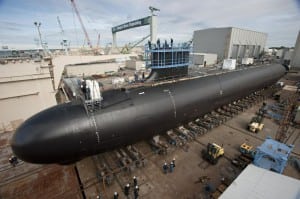Three House representatives on Friday introduced a bill that seeks to allow the U.S. government to transfer up to two Virginia-class attack submarines to Australia as part of the trilateral AUKUS agreement.
The bill, titled the AUKUS Undersea Defense Act, primarily authorizes the president to transfer two submarines, their nuclear reactors and the fuel to Australia, with costs to be borne by Australia. This is aimed at the primary part of the AUKUS agreement among the U.S., U.K. and Australia, called Pillar I.
The legislation is sponsored by Reps. Joe Courtney (D-Conn), ranking member of the House Armed Services Seapower and Projection Forces subcommittee; Gregory Meeks (D-N.Y.), ranking member of the House Foreign Affairs Committee; and Ami Bera (D-Calif.), ranking member of the House Foreign Affairs Subcommittee on the Indo-Pacific.

The bill also includes a section allowing the president to transfer or authorize the export of services to Australia that may be directly exported to Australian private sector personnel to support the development of Australia’s submarine industrial base “necessary for submarine security activities between Australia, the United Kingdom, and the United States.”
In essence, this would allow the U.S. to train private sector Australian personnel while also taking in Australian financial contributions for these submarines and services into the American defense industrial base.
This largely meets the three legislative proposals submitted by the Defense Department last month. Those proposals sought to allow it to transfer the two submarines, direct proceeds of the sale towards acquiring new submarines or directed towards other needed submarine industrial base improvements, allow the Defense Department to accept Australian payments to help improve the U.S. industrial base, and allow private sector Australian personnel to be trained by the U.S. Navy and U.S. contractors (Defense Daily, May 18).
In March, the U.S., U.K. and Australian governments announced their “optimal pathway” to help Australia field and build its own nuclear powered attack submarines under the AUKUS agreement, aimed at replacing the aging Collins-class diesel-electric boats (Defense Daily, March 13).
When the legislation was introduced, Courtney said in a statement that it has been three months since the pathway was announced, so it is time for the next step.
“Introduction of this enabling legislation is a critical first step towards swift congressional action to support this enterprise. I am excited to join my colleagues Greg Meeks and Ami Bera, who are leaders on the House Foreign Affairs Committee, to introduce these measures,” Courtney said.
He noted the bill was designed in collaboration with the Defense Department and argued it “will demonstrate the commitment of the U.S. Congress to the AUKUS mission.”
The three House members introduced this bill after Assistant Secretary of Defense for Strategies, Plans, and Capabilities Mara Karlin recently testified before the House Foreign Affairs Committee on May 23 that legislative action soon will send a message to the industrial base.
She said enabling legislation in line with DoD’s proposals for Pilar I is “a signal of our commitment to AUKUS, which is critical for generating deterrence across every phase of the optimal pathway. Acting now sends a message to our defense industrial base as well that there will be a persistent flow of business to come…and really ensuring that that submarine industrial base is able to start taking the steps that it needs with Australia’s contribution.”
Karlin added that “absent this legislative proposal, we actually don’t have a way to take that money in,” she said, in reference to financial commitments Australia said it intends to provide the U.S. in exchange for other elements of the security agreement.
Virginia-class attack submarines are built by General Dynamics Electric Boat [GD] and HII Newport News Shipbuilder [HII]. Courtney’s district includes the Electric Boat shipyard in Groton, Conn.